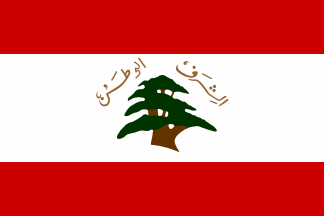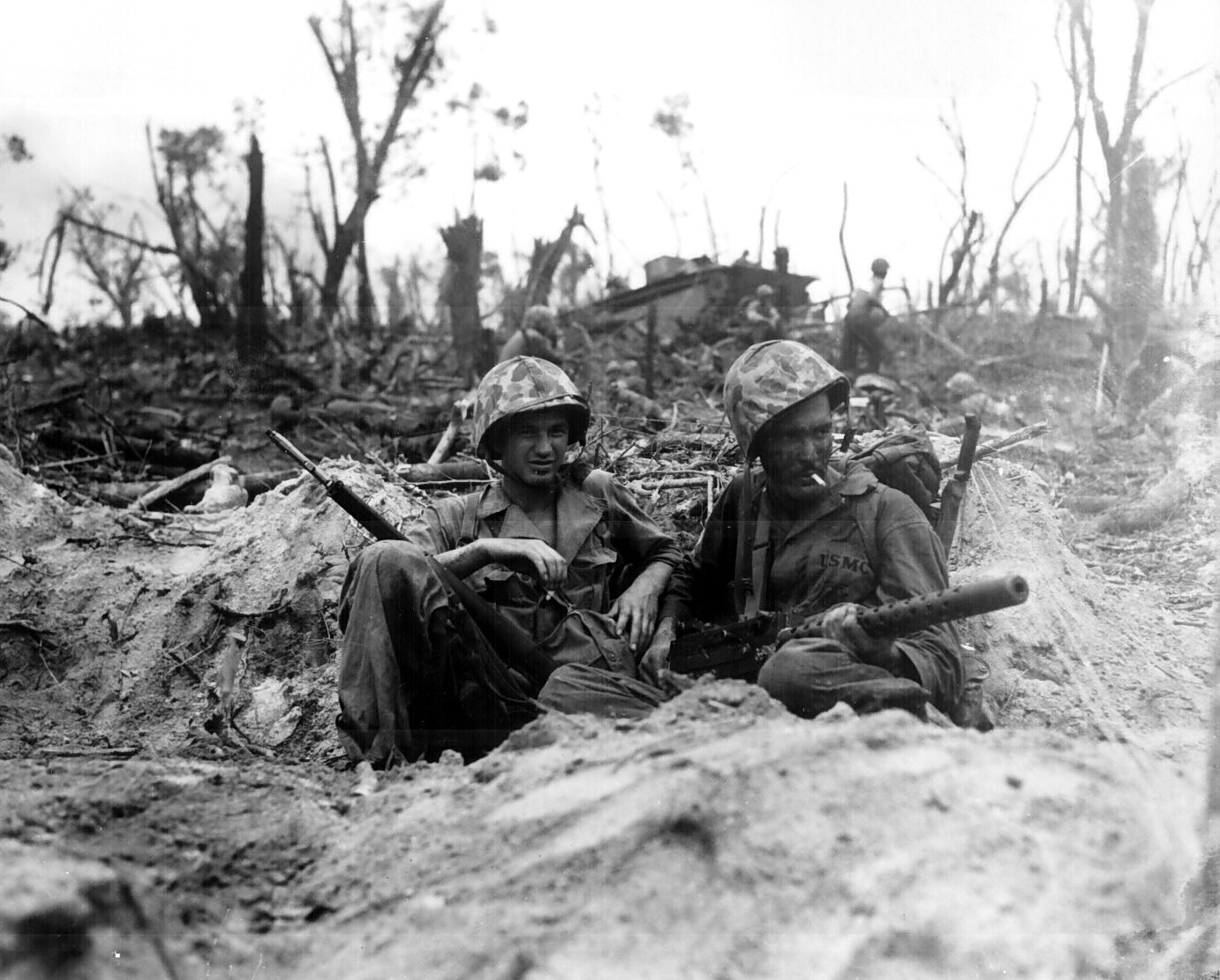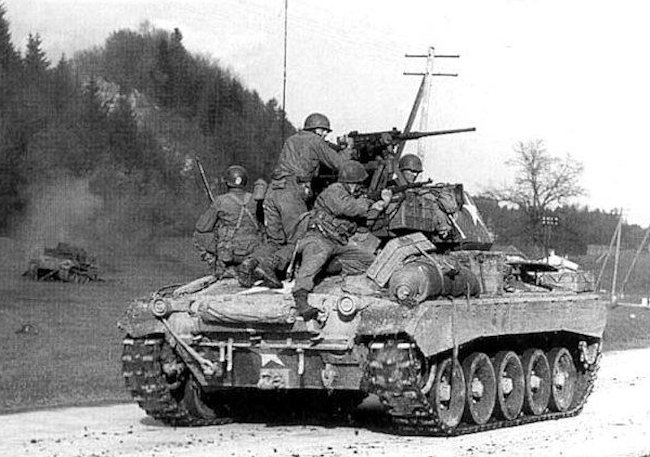|
M42 Duster
The M42 40 mm self-propelled anti-aircraft gun, or "Duster," is an American armored light air-defense gun built for the United States Army from 1952 until December 1960, in service until 1988. Production of this vehicle was performed by the tank division of the General Motors Corporation. It used components from the M41 light tank and was constructed of all-welded steel. A total of 3,700 M42s were built. The vehicle has a crew of six and weighs 22,500 kg (49,500 lb) fully loaded. Maximum speed is with a range of 100 miles (160 km). Armament consists of fully automatic twin 40 mm M2A1 Bofors, with a rate of fire of 2×120 rounds per minute (rpm) enabling nearly 85 seconds of fire time before running out of ammo, and either a .30 caliber Browning M1919A4 or 7.62mm M60 machine gun. The 500 hp, six-cylinder, Continental (or Lycoming Engines), air-cooled, gasoline engine is located in the rear of the vehicle. It was driven by a cross-drive, two-speed Allis ... [...More Info...] [...Related Items...] OR: [Wikipedia] [Google] [Baidu] |
National Route 9 (Vietnam)
National Route 9 () runs across Vietnam roughly in line with the 17th Parallel. The route includes two segments. The segment called National Route 9A begins at Đông Hà and ends at Lao Bảo on the Vietnam-Laos border and is entirely within Quảng Trị Province. The 8 km-long segment called National Route 9B begins at Dong Ha and runs eastward to Cửa Việt Port. Road layout Route 9 runs through the following towns and cities of Quảng Trị Province: * Đông Hà, where it connects with Route 1 * Cam Lộ * Ca Lu * Tân Hợp, where it connects to the Ho Chi Minh Highway * Khe Sanh * Lang Vei * Lao Bảo where it connects to Route 9E in Laos which runs through Xépôn and Seno to Savannakhet Specifications *Total length: 82 km *Road width: 10 m *Road surface: paved with asphalt History Route Coloniale 9 or RC9 was constructed by the French in the early 20th century. The road was built to connect the towns along the Mekong River in present-day Laos ove ... [...More Info...] [...Related Items...] OR: [Wikipedia] [Google] [Baidu] |
M1919 Browning Machine Gun
The M1919 Browning is a .30-06 Springfield, .30 caliber medium machine gun that was widely used during the 20th century, especially during World War II, the Korean War, and the Vietnam War. The M1919 saw service as a light infantry, coaxial weapon, coaxial, mounted, aircraft, and anti-aircraft machine gun by the U.S and many other countries. The M1919 was an air-cooled development of the standard U.S. machine gun of World War I, the John Browning, John M. Browning-designed water-cooled M1917 Browning machine gun, M1917. The emergence of general-purpose machine guns in the 1950s pushed the M1919 into secondary roles in many cases, especially after the arrival of the M60 machine gun, M60 in US Army service. The United States Navy also converted many to 7.62 mm NATO and designated them Mk 21 Mod 0; they were commonly used on riverine craft in the 1960s and 1970s in Vietnam. Many NATO countries also converted their examples to 7.62 mm caliber, and these remained in service well ... [...More Info...] [...Related Items...] OR: [Wikipedia] [Google] [Baidu] |
South Vietnam
South Vietnam, officially the Republic of Vietnam (RVN; , VNCH), was a country in Southeast Asia that existed from 1955 to 1975. It first garnered Diplomatic recognition, international recognition in 1949 as the State of Vietnam within the French Union, with its capital at Saigon, before becoming a republic in 1955, when the southern half of Vietnam was a member of the Western Bloc during part of the Cold War after the 1954 Geneva Conference, 1954 division of Vietnam. South Vietnam was bordered by North Vietnam (Democratic Republic of Vietnam) to the north, Kingdom of Laos, Laos to the northwest, Khmer Republic, Cambodia to the southwest, and Thailand across the Gulf of Thailand to the southwest. Its sovereignty was recognized by the United States and 87 other nations, though it failed to gain admission into the United Nations as a result of a Soviet Union, Soviet veto in 1957. It was succeeded by the Provisional Revolutionary Government of the Republic of South Vietnam, Rep ... [...More Info...] [...Related Items...] OR: [Wikipedia] [Google] [Baidu] |
MACV Compound Duster Post-Tet Feb
The U.S. Military Assistance Command, Vietnam (MACV) was a joint-service command of the United States Department of Defense, composed of forces from the United States Army, United States Navy, and United States Air Force, as well as their respective special operations forces. MACV was created on 8 February 1962, in response to the increase in United States military assistance to South Vietnam. MACV was implemented to assist and oversee the Military Assistance Advisory Group (MAAG) Vietnam while the Viet Cong insurgency was under way. It was reorganized on 15 May 1964 and absorbed MAAG Vietnam when the deployment of combat units became too large for the advisory group to control. General Paul D. Harkins was the first commanding general of MACV (COMUSMACV), and was previously the commander of MAAG Vietnam. After reorganization he was succeeded by General William Westmoreland in June 1964, followed by General Creighton W. Abrams (July 1968) and General Frederick C. Weyand (June 19 ... [...More Info...] [...Related Items...] OR: [Wikipedia] [Google] [Baidu] |
Panama Canal Zone
The Panama Canal Zone (), also known as just the Canal Zone, was a International zone#Concessions, concession of the United States located in the Isthmus of Panama that existed from 1903 to 1979. It consisted of the Panama Canal and an area generally extending on each side of the centerline, but excluding Panama City and Colón, Panama, Colón. Its capital was Balboa, Panama, Balboa. The Panama Canal Zone was created on November 18, 1903, from the Separation of Panama from Colombia, territory of Panama; it was established with the signing of the Hay–Bunau-Varilla Treaty, which allowed for the construction of the Panama Canal within the territory by the United States. The zone existed until October 1, 1979, when it was incorporated back into Panama. In 1904, the Isthmian Canal Commission, Isthmian Canal Convention was proclaimed. In it, the Republic of Panama granted to the United States in perpetuity the use, occupation, and control of a zone of land and land underwater for ... [...More Info...] [...Related Items...] OR: [Wikipedia] [Google] [Baidu] |
517th Air Defense Artillery Regiment
517th may refer to: * 517th Air Defense Group, disbanded United States Air Force organization * 517th Airlift Squadron (517 AS), part of the 3d Wing at Elmendorf Air Force Base, Alaska *517th Parachute Infantry Regiment (United States) (517th PIR), separate infantry regiment of the United States Army *517th Parachute Regimental Combat Team The 517th Parachute Regimental Combat Team (517th PRCT) was an Airborne forces, airborne, specifically a Paratrooper, parachute infantry, regiment of the United States Army that was formed in March 1943 during World War II, training at Camp Toc ... (517th PRCT), one of the U.S. Army's first elite combat units * 517th Strategic Fighter Squadron, inactive United States Air Force unit See also * 517 (number) * 517, the year 517 (DXVII) of the Julian calendar * 517 BC {{mil-unit-dis ... [...More Info...] [...Related Items...] OR: [Wikipedia] [Google] [Baidu] |
MIM-23 HAWK
The Raytheon MIM-23 HAWK ("Homing All the Way Killer") is an American medium-range surface-to-air missile. It was designed to be a much more mobile counterpart to the MIM-14 Nike Hercules, trading off range and altitude capability for a much smaller size and weight. Its low-level performance was greatly improved over Nike through the adoption of new radars and a continuous wave semi-active radar homing guidance system. It entered service with the US Army in 1959. In 1971 it underwent a major improvement program as the Improved Hawk, or I-Hawk, which made several improvements to the missile and replaced all of the radar systems with new models. Improvements continued throughout the next twenty years, adding improved electronic counter-countermeasures, ECCM, a potential home-on-jam feature, and in 1995, a new warhead that made it capable against short-range tactical ballistic missiles. ''Jane's Information Group, Jane's'' reported that the original system's single shot kill probab ... [...More Info...] [...Related Items...] OR: [Wikipedia] [Google] [Baidu] |
Fire Control System
A fire-control system (FCS) is a number of components working together, usually a gun data computer, a Director (military), director and radar, which is designed to assist a ranged weapon system to target, track, and hit a target. It performs the same task as a human Crew-served weapon, gunner firing a weapon, but attempts to do so faster and more accurately. Naval fire control Origins The original fire-control systems were developed for ships. The early history of naval fire control was dominated by the engagement of targets within visual range (also referred to as indirect fire, direct fire). In fact, most naval engagements before 1800 were conducted at ranges of . Even during the American Civil War, the Battle of Hampton Roads, famous engagement between and was often conducted at less than range. Rapid technical improvements in the late 19th century greatly increased the range at which gunfire was possible. Rifled guns of much larger size firing explosive shells of lig ... [...More Info...] [...Related Items...] OR: [Wikipedia] [Google] [Baidu] |
Radar
Radar is a system that uses radio waves to determine the distance ('' ranging''), direction ( azimuth and elevation angles), and radial velocity of objects relative to the site. It is a radiodetermination method used to detect and track aircraft, ships, spacecraft, guided missiles, motor vehicles, map weather formations, and terrain. The term ''RADAR'' was coined in 1940 by the United States Navy as an acronym for "radio detection and ranging". The term ''radar'' has since entered English and other languages as an anacronym, a common noun, losing all capitalization. A radar system consists of a transmitter producing electromagnetic waves in the radio or microwave domain, a transmitting antenna, a receiving antenna (often the same antenna is used for transmitting and receiving) and a receiver and processor to determine properties of the objects. Radio waves (pulsed or continuous) from the transmitter reflect off the objects and return to the receiver, giving ... [...More Info...] [...Related Items...] OR: [Wikipedia] [Google] [Baidu] |
M19 Multiple Gun Motor Carriage
The M19 multiple gun motor carriage (MGMC) was a World War II United States Army self-propelled anti-aircraft weapon on the M24 light tank chassis. It was equipped with two Bofors 40 mm guns. It was produced by Cadillac and Massey Ferguson of Canada near the end of 1944. The M19 was developed from the T65 which was based on the M5 light tank chassis. With the M5 going out of production, the project adopted the M24 Chaffee light tank chassis and was designated the T65E1. It was accepted into service in May 1944 as the M19 MGMC, equipping several U.S. Army anti-aircraft units during World War II. The M19A1 was an improved variant with an auxiliary engine and spare barrels for the 40 mm Bofors guns. Although all M19s were produced during World War II, they did not reach operational capability until after the cessation of hostilities. The M19's first combat was in Korea in 1950 against North Korean forces. Specifications The M19 MGMC had similar specifications to the ... [...More Info...] [...Related Items...] OR: [Wikipedia] [Google] [Baidu] |
M24 Chaffee
The M24 Chaffee (officially light tank M24) was an American light tank used during the later part of World War II; it was also used in post–World War II conflicts including the Korean War, and by the French in the Algerian War, War in Algeria and the First Indochina War. In British service it was given the service name ''Chaffee'' after the United States Army General officer, general, Adna R. Chaffee Jr., who helped develop the use of tanks in the United States Armed Forces, United States armed forces. Although the M41 Walker Bulldog was developed as a replacement, M24s were not mostly removed from U.S. and NATO armies until the 1960s and remained in service with some Third World countries. Development and production history British combat experience in the North African campaign identified several shortcomings of the M3 Stuart light tank, especially the performance of its 37 mm Gun M3, 37 mm cannon. A 75 mm gun was experimentally fitted to a howitzer motor carriage M8 & ... [...More Info...] [...Related Items...] OR: [Wikipedia] [Google] [Baidu] |
Korean War
The Korean War (25 June 1950 – 27 July 1953) was an armed conflict on the Korean Peninsula fought between North Korea (Democratic People's Republic of Korea; DPRK) and South Korea (Republic of Korea; ROK) and their allies. North Korea was supported by China and the Soviet Union, while South Korea was supported by the United Nations Command (UNC) led by the United States. The conflict was one of the first major proxy wars of the Cold War. Fighting ended in 1953 with an armistice but no peace treaty, leading to the ongoing Korean conflict. After the end of World War II in 1945, Korea, which had been a Korea under Japanese rule, Japanese colony for 35 years, was Division of Korea, divided by the Soviet Union and the United States into two occupation zones at the 38th parallel north, 38th parallel, with plans for a future independent state. Due to political disagreements and influence from their backers, the zones formed their governments in 1948. North Korea was led by Kim Il S ... [...More Info...] [...Related Items...] OR: [Wikipedia] [Google] [Baidu] |







